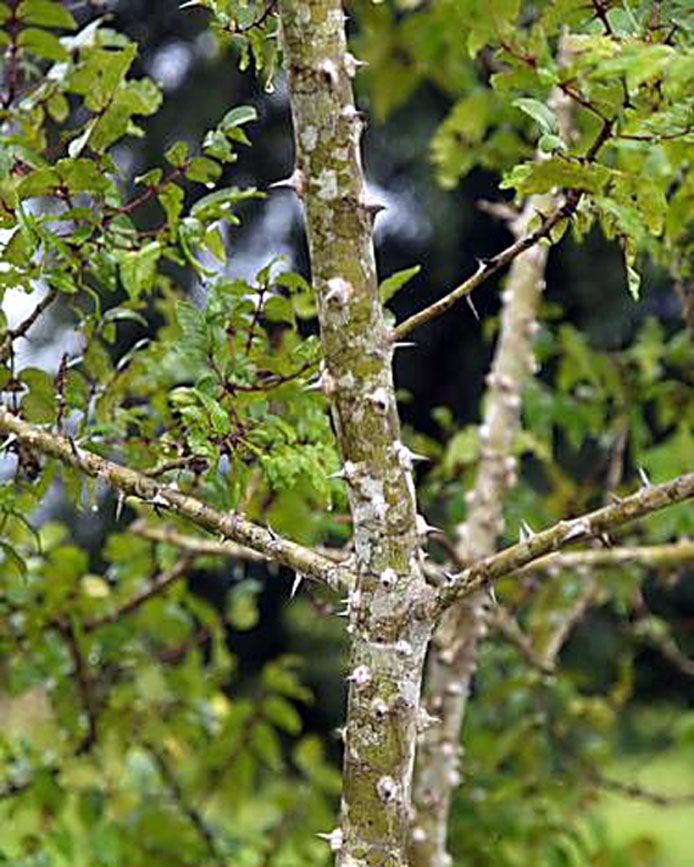Dimple Gupta and
Yash Pal Sharma
Use of medicinal plants or their products have acquired a centre stage in traditional medicine either to prevent ailments or as a curative measure against distress and diseases. They provide a wide variety of bioactive natural products, such as phenolics, flavonoids, quinones, coumarins, lignans, amines, vitamins and other endogenous metabolites. These compounds have multiple biological activities including anti-oxidant properties and, as such are in great demand in nutraceutical (dietary therapy), pharmaceutical and cosmetic industry. About 80% of the world population, primarily in the developing countries, depends on herbal medicines for primary health care since they are cost effective, easily available and have negligible side effects.
Among different medicinal plants, Zanthoxylum (family: Rutaceae) is one of such genus which possess high medicinal, economical as well as ecological importance and have about 549 species spreading mainly in tropical and temperate regions of the world. In India, 11 species of this genus are reported of which Z. armatum DC commonly called as Timbru is the most exploited one.
Diversity and Origin
Zanthoxylum armatum DC. is a deciduous xerophytic shrub or small tree that grows in well drained alluvial, black soil. It is distributed throughout China, Taiwan, Nepal, Philippines, Malaysia, Pakistan and Japan. In India, it has been reported from warmer valleys and foot hills of the Himalaya of Jammu and Kashmir at an altitudinal range of 1000-2100m, in the Eastern Ghats in Orissa and Andhra Pradesh at 1200m and the lesser Himalayan regions in the north eastern part of India including Khasi hills, Meghalaya, Mizoram and Manipur. Valleys and thickets in the mountains, wasteland and the under-storey of mixed forest are customary locations of the species.
The name Zanthoxylum comes from the word Xanthoxylum which is derived from the Greek word ‘xanthon xylon’ which means ‘yellow wood’. It is known by many vernaculars such as ‘Tejbal’ in Hindi, ‘Tumpunal’ in Tamil, ‘Toothache tree’ or ‘Indian Prickly Ash’ in English, ‘Gira’ in Bengali, and ‘Andkaka Dhiva’ or Tumburi in Sanskrit. In Jammu region, it is commonly referred to as ‘Timbru’ (in Dogri) and ‘Timber’ (in Pahari).
Traditional/folk uses
Timbru is known as an important magical plant as whole plant including stem, bark, fruits and seeds possess medicinal properties and has been used as a medicine in both traditional and Ayurvedic treatments for ages.
Their fruits are used in the form of condiments, spices and medicine. Finely ground fruits and seeds are employed as an aromatic tonic in fever, dyspepsia and expelling roundworms. During winter, a soup/decoction prepared from the dried fruits is consumed as it is believed to give warmth to the body and provide relief from abdominal pain. Powdered fruit mixed with Mentha sp. and table salt and eaten with boiled egg is good for curing chest infection and digestive problems. Traditional appetizer, “Timbru chutney” widely relished in the household of Northern India is prepared from fresh, or dried fruits of timbru. Besides, pickles made from the fruits aids in relieving cold, cough, headache, tonsillitis, limbs numbness, and dizziness/vertigo. The intake of timbru is known to benefit people suffering from rheumatism. Teeth cleaning sticks (datun) as well as walking sticks are made out of its branches. Their bark is also utilized as traditional dye resource.
Due to their disinfectant and antiseptic properties, the fruits are used to cure toothache, skin diseases and snake bites. In addition, timbru exhibits good antibacterial and antifungal properties. Bacterial infections of the mouth, digestive system and urinary tract are successfully treated with timbru fruits. Lupeol, a monoterpene found in timbru extracts, act as therapeutic and chemopreventive agent for the treatment of inflammation and cancer.
Significance and role of timbru in everyday life of local folks can be successfully illustrated in numerous works of folk poetry and songs…. Asen kutti tez taraar chutney timbru di , naar-daana kane dhanya payaa, marchan paayiin char…chutney timbru di…
Commercial value
As a high value medicinal plant, the various pharmaceutical, companies generally use timbru fruit for making polyherbal unani and ayurvedic formulations (Tejowatyadya Grita, Tumbawardi Churna)and in different types of toothpaste. Due to its appealing aroma and valuable perfume, timur is used in the manufacture of several health-care and cosmetic products. With its increasing commercial value, it has become a profitable non-timber forest product (NTFP).
Vulnerability of Timbru plant
Z. armatum is not a fast growing species and has low population size. A growing demand of timbru has caused a serious reduction in native population due to over-exploitation of both fruits and wood for the economic benefits. In addition, unabated deforestation and rapid proliferation of invasive weeds such as Lantana in timbru growing areas are also creating problems for the survival of this native species. It is a matter of concern that this target species (Zanthoxylum armatum) has been declared as an endangered species as per International Union for Conservation of Nature (IUCN) criteria. Therefore, there is an ardent need for exploring its regeneration potentiality and conservation strategies. Here lies an opportunity for all of us…..Monsoon is round the corner…Let’s plant Timbru saplings in this season…
(The authors are from Department of Botany, University of Jammu.)


